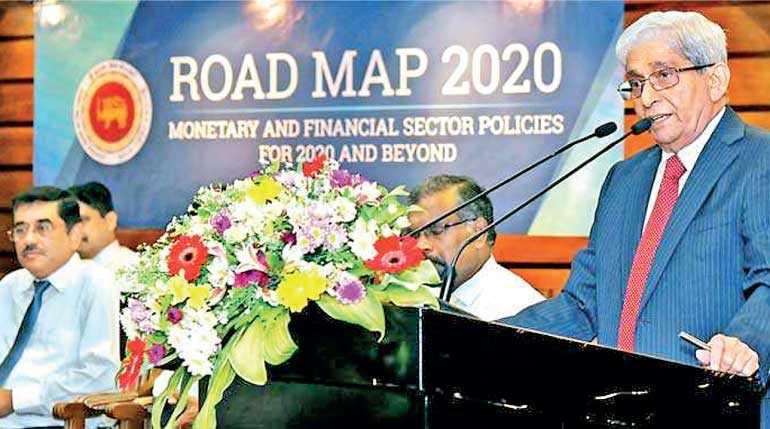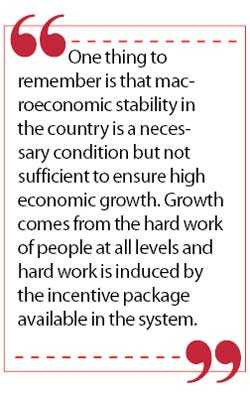Monday Feb 24, 2025
Monday Feb 24, 2025
Monday, 13 January 2020 09:40 - - {{hitsCtrl.values.hits}}

Central Bank Governor Prof. W.D. Lakshman speaking at the launch of the Central Bank’s Road Map for 2020 and Beyond
The roadmap is the map of the Monetary Board
Last week, the new Governor of the Central Bank, Prof. W.D. Lakshman, unveiled the Central Bank’s Road Map for 2020 and Beyond before a select audience. The speech delivered by Lakshman can be accessed at https://youtu.be/ehHMUU42XLM . 
Though it is commonly known as the Central Bank’s roadmap, it is in effect the roadmap of the Monetary Board which owns the Central Bank. Hence, the blame for its failure or credit for its success should not be passed on to Lakshman or any senior officer of the bank but to the Monetary Board as a corporate body. Accordingly, wherever the bank has been referred to in this article or elsewhere, it should be construed as a reference to the Monetary Board.
The practice of announcing a roadmap was started by Cabraal
The practice of presenting the Monetary Board’s action program for the upcoming year was started by former Governor Ajith Nivard Cabraal in January 2007, just six months after he assumed office.
Cabraal’s view was that by pre-announcing the Board’s policy stance and action program, the bank could manage the public’s expectations effectively, a necessary condition for the success of its policies. This he did when the country was fighting a destructive internecine war and all macroeconomic factors were showing changes from bad to worse.
At that time, inflation was rising at above 20%, foreign reserves had fallen to a critically low level, the rupee was under constant pressure for depreciation, Government revenue as a share of GDP was falling and expenditure, due to boosted war related spending, was ballooning. It produced sizable deficits in the current account, primary account and the overall budget. Due to this gloomy climate, inflationary expectations were running high. This last factor had adversely affected the Government’s borrowing plans. While resources from domestic borrowing sources were scanty, they were available at a high price to the Government. Sri Lanka had not yet tapped the foreign commercial markets and therefore it had to depend solely on funding by multilateral agencies and friendly countries. But that was also not available in sufficient amounts.
As a result, the Central Bank could not effectively implement its monetary policy. Hence, in order to educate all its stakeholders – the public, politicians, international agencies, financial institutions, the media and employees – Cabraal thought that the bank’s futuristic vision and plans should be made public at the beginning of the year. This was welcomed by financial markets. Having realised its advantage for managing expectations, all successive Governors too continued to follow this practice.
Strong institutions convert Governors from outside into strong central bankers
There is a general feeling among some that an outsider emerging as the Governor of the Central Bank is not salutary. This may be true in the case of weak institutions. In such cases, the outsider makes the institution fit his wishes and policies. But if the institution is strong, it will align the outsider with its long-established vision, thinking and policies. This is exactly what has happened in the case of central banks with strong institutional traditions.
In India, the Manmohan Singh Government brought in Finance Secretary D. Subbarao as the Governor of the Reserve Bank of India in 2008 because incumbent Governor Y. Venugopal Reddy was considered too independent. But within months, Subbarao got fully converted in the central banking ideology and thinking and became more independent in his deals with the Government than even Reddy.
In 2004, Sunil Mendis walked away from Hayleys and into the Governor’s office promising that the Central Bank would take action to improve agricultural productivity under his management. But he soon became a fully-fledged monetary hawk, someone who strongly believed in the efficacy of conservative monetary policies.
Cabraal walked into the bank in 2006 with a mandate from the political authority in one hand and Mahinda Chinthana – the policy document of then-incumbent President Mahinda Rajapaksa – in the other. Cabraal was a quick learner and within months, he adopted a strong central banking philosophy. 
The current Governor Lakshman, a known social democrat, announced at his first press conference after assuming office that he did not believe in Washington-consensus-type neoliberal economic policies. The speech delivered on the occasion of the release of the Road Map 2020 is demonstrative of his swift move away from this stance. He has reiterated that he will do his best to sustain and add to the institutional greatness of the Central Bank and uphold the great traditions it has built over the past seven decades. This is a salutary development.
Covering the full range of work of the Central Bank
The Road Map for 2020 and beyond (available at: https://www.cbsl.gov.lk/sites/default/files/cbslweb_documents/press/pr/press_20200106
_road_map_2020_e.pdf) presents an account of the state of the economy today before venturing into the three areas of policy it has covered: monetary policy, financial stability policy and policies relating to its agency functions.
The sad state of Sri Lanka’s economy
The present state of the economy is exactly what independent economists had diagnosed earlier and what the Central Bank had not openly accepted.
According to the roadmap, Sri Lanka’s economy, which is at a crossroads today, is suffering from a number of ailments. Economic growth is below potential growth. There are many poverty pockets in the country despite the overall reduction of the poverty headcount. Productive resources are being underutilised and one glaring example is agriculture. There has been inadequate expansion and diversification of exports despite the policies adopted in the past. The country has generated foreign funding but most of such funding has added to its debt stock. Thus, the non-debt foreign funding flow in the form of investments in the capital market and business enterprises has also been short compared to requirements. There have been wide fluctuations in interest rates and credit flows. Budget deficits have been beyond the country’s tolerable level and public debt has been inordinately high.
The path to becoming a rich country
These are in fact serious macroeconomic ailments from which the country had been suffering for a long period of time. Independent policy analysts and think tanks have been repeatedly drawing the attention of successive governments to the need for resolving them to place the country on a needed high-growth path. Without resolving them, there is no way for Sri Lanka to become a rich country.
In retrospect, the required growth to elevate Sri Lanka to the status of a rich economy within about 40 years has been around 8% per annum after allowing for an annual population growth of about 1%. Still, the annual average growth rate during the post-independence period has been well below this level at a meagre 4.5%. Hence, Sri Lanka has become a laggard among its peer countries. Prospectively, if Sri Lanka maintains average economic growth of 6.5% in the future, after allowing for population growth of 1%, it could become a rich country within about 20 years.
It is necessary to adopt an effective economic policy program for Sri Lanka to attain this goal. The roadmap has qualified these policies to be “innovative”, emanating from and backed by “innovative” thinking. Since the economic policy framework to accelerate the economy comes within the purview of the Government, the suggestion here is that the Government should be an innovative institution. Such policy should be framed by those who have an innovative mindset.
Immediate challenge of the Government
As I have argued in the previous article in this series, Sri Lanka’s immediate challenge has been to reverse the declining trend in economic growth, generate sufficient foreign exchange resources to meet the country’s foreign debt repayment obligations and provide relief to businesses, mainly in the small and medium enterprise (SME) sector, which has been suffering from exposure to a downswing in the business cycle.
As I have presented in the article under the title ‘Fixing lending rates and waiving farmer loans: two policies that do not augur well for borrowers’ (available at: http://www.ft.lk/columns/Fixing-lending-rates-and-waiving-farmer-loans-two-policies-that-do-not-augur-well-for-borrowers/4-687972), many entrepreneurs in the small business sector have begun to experience shortages in cash due to subdued market demand. These entrepreneurs have been turned away by formal banking institutions and, as a result, have become unwilling customers of informal money lenders.
As I have documented in the article mentioned above, a loan could be raised from these money lenders in less than an hour. Once the loan is approved, the loan proceeds are delivered most conveniently to the doorstep of the borrower instantly.
The loan recovery and interest collection are also done by calling on the place of business of the borrower. The only complaint by borrowers is the exorbitant interest rates charged at 10% per month and the short maturity of loans within 100 days. Since these small entrepreneurs cannot earn profits at more than 10% per month, there is not enough cash to service the loans.
Hence, like the Sri Lankan Government, old loans are repaid by raising new loans. Hence, it is inevitable that they get into an inescapable debt trap. Therefore, the relief package extended to the SME sector is a welcome development.
The Central Bank can only facilitate growth
The Central Bank can only play a facilitating role in accelerating economic growth. The main responsibility in doing so rests with the Government. That is because, unlike the Government which can undertake real enterprises by taxing people or by borrowing funds, the bank is not supposed to do so by using the only weapon it has, namely, the ability to print money and acquire real resources from the economy.
The Central Bank is expected to implement its monetary policy, which is, changing interest rates and credit levels impartially without favouring any particular business enterprise. If it owns real enterprises, it may be compelled to offer favours to the enterprises that it owns. Hence, in the Monetary Law Act, the Monetary Board has been precluded from owning businesses. In this context, the bank’s facilitating role comes from maintaining ‘economic and price stability’ – a more cogent way of describing macroeconomic stability – within the system. When the prices are stable, businesses will be able to take a longer term view of the economy and make investments for the future.
The need for a proper incentive package
One thing to remember is that macroeconomic stability in the country is a necessary condition but not sufficient to ensure high economic growth. Growth comes from the hard work of people at all levels and hard work is induced by the incentive package available in the system.
The main ingredients in the incentive package are appropriate remuneration for work, protection of property rights, observance of the rule of law and incentives for improving business practices by using new technologies.
Ironically, they all come in what is now labelled neoliberal policies. These are all responsibilities of the Government and not of the Central Bank. The bank can only advise the Government and it is in the interest of the Government to listen to such advice. In this connection, both the Central Bank and the Government have to collaborate.
Continued engagement with IMF a must
Road Map for 2020 and Beyond has accepted, contrary to what many in the Government believe, that Sri Lanka should continue to engage with the International Monetary Fund (IMF). The country has undergone the sixth review of the present Extended Fund Facility (EFF) by the IMF and received the seventh installment of the loan it had gotten from the fund.
It is only the eighth installment which is to be disbursed in the current year.
The successful completion of IMF program is vital for Sri Lanka because it has to borrow from international commercial markets to gain capacity to honour the debt repayment obligations falling on the country in 2020 and beyond. Once the present EFF is completed, it is necessary to go for a new facility immediately to allow Sri Lanka to maintain its creditworthiness in the eyes of foreign lenders. This is of course a short-term measure and in the long run, necessary policy reforms should be introduced by the Government to increase the net volume of foreign exchange earnings by the country.
MLA should be amended
The roadmap has pronounced that the bank will continue to follow the easing of monetary policy in the years to come within the permissible limit of maintaining the inflation rate between 4% and 6%. This is in fact the acceptance of the inflation targeting monetary policy framework presently being followed by the bank by the new regime. It is a laudable development. However, two requirements are needed for the bank to follow this policy.
One is that when inflation moves above the upper limit of 6%, the bank will have to commence tightening monetary policy. The other is that the bank should be given full freedom to continue with this policy by appropriately amending the Monetary Law Act.
In this context, a new Monetary Law Act had already been gazetted as a Bill by the previous Government. While the roadmap is silent on this already gazetted draft bill, it has made a passing reference that the bank will make adjustments to the Monetary Law Act to align it with global best practices. It is understandable that the new Government should take time to study the proposed Act. But an amendment to the law to improve the bank’s governance, enhance its independence, transparency and accountability and establish proper fiscal-monetary coordination is a must today. The new Government cannot ignore this requirement.
Hence, the Government’s cooperation is needed to attain the goals of the bank’s Road Map for 2020 and Beyond.
(The writer, a former Deputy Governor of the Central Bank of Sri Lanka, can be reached at [email protected])
Discover Kapruka, the leading online shopping platform in Sri Lanka, where you can conveniently send Gifts and Flowers to your loved ones for any event including Valentine ’s Day. Explore a wide range of popular Shopping Categories on Kapruka, including Toys, Groceries, Electronics, Birthday Cakes, Fruits, Chocolates, Flower Bouquets, Clothing, Watches, Lingerie, Gift Sets and Jewellery. Also if you’re interested in selling with Kapruka, Partner Central by Kapruka is the best solution to start with. Moreover, through Kapruka Global Shop, you can also enjoy the convenience of purchasing products from renowned platforms like Amazon and eBay and have them delivered to Sri Lanka.
Discover Kapruka, the leading online shopping platform in Sri Lanka, where you can conveniently send Gifts and Flowers to your loved ones for any event including Valentine ’s Day. Explore a wide range of popular Shopping Categories on Kapruka, including Toys, Groceries, Electronics, Birthday Cakes, Fruits, Chocolates, Flower Bouquets, Clothing, Watches, Lingerie, Gift Sets and Jewellery. Also if you’re interested in selling with Kapruka, Partner Central by Kapruka is the best solution to start with. Moreover, through Kapruka Global Shop, you can also enjoy the convenience of purchasing products from renowned platforms like Amazon and eBay and have them delivered to Sri Lanka.